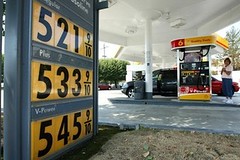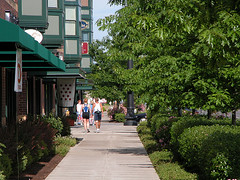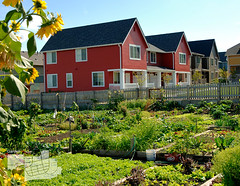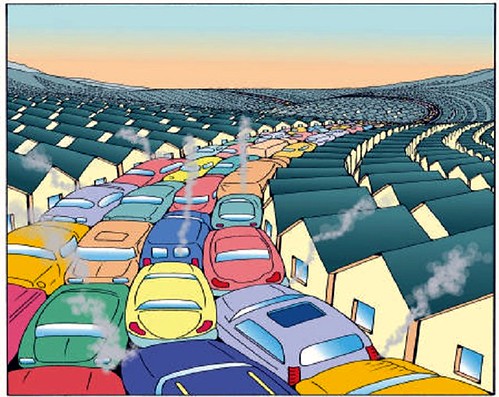What cities should do to become more sustainable and resilient (and it’s not what they are doing currently)

Posted March 30, 2010 at 1:24PM
Warren Karlenzig, founder and president of the consultancy Common Current, believes that many cities’ current sustainability efforts are misplaced. In particular, he asks, “should efforts such as focusing on renewable energy and energy efficiency [to power buildings] deserve the highest priority, when a city such as San Francisco produces 78 percent of its greenhouse gases from transportation and only 17 percent from buildings?” The question appears in one of two recent posts by Karlenzig on sustainable resilience (“Urban Resilience Planning for Dummies”) on the blog Green Flow. It’s a good one.
In the second post (“Urban Resilience for Dummies, Part 2: Failing the Milk Test”), he answers his own question with some advice for environmentalists and conscientious municipal officials:
[Considering the need to plan for resilience in the face of climate change and diminishing resources, - especially fresh water and oil], “what aspect of U.S. metro development stands out as the most ill-advised and risky? Short answer: exurban sprawl.
‘If the ‘Great Recession’ taught us anything, it is that allowing the unrestrained sprawl of energy-inefficient communities and infrastructure is a now-bankrupt economic development strategy and constitutes a recipe for continued disaster on every level.”
I would go even further and ask why we enviros trumpet successes in getting pledges from big-city mayors to cut energy consumption and emissions in their jurisdictions while focusing almost no attention on the suburbs, where the real inefficiencies are, especially for transportation. As David Owen puts it, further shrinking the per-capita energy profile of an already-efficient place such as Manhattan is “like putting skinny people on diets.”
 Back to Karlenzig, he points out that a recent British industry study forecasts a major oil crunch by 2014-15 that could potentially mean shorter supplies and much higher prices for gasoline. Because US cities do not use oil for electric power generation, he believes we should be shifting more of our resources to pursuing efficiencies in transportation and other key areas that will be more severely impacted by the high price of oil.
Back to Karlenzig, he points out that a recent British industry study forecasts a major oil crunch by 2014-15 that could potentially mean shorter supplies and much higher prices for gasoline. Because US cities do not use oil for electric power generation, he believes we should be shifting more of our resources to pursuing efficiencies in transportation and other key areas that will be more severely impacted by the high price of oil.
Of course, NRDC believes we should be doing both. Even Karlenzig is quick to concede that his concern about currently neglected issues “doesn't mean that increasing renewable energy and energy efficiency shouldn't be part of every community's planning, projects and budgets.” But he does argue that “at no time has effective planning, land use and public transit been so key to ensuring economic vitality, as well as equity (access to jobs and services with transit), environmental sustainability, climate security and health.”
Karlenzig also believes that we are not doing enough to address water consumption, particularly in the West, and food security, both of which also have close links to energy and carbon emissions.
Taken from his first post, here are Karlenzig’s “general urban resiliency rules of thumb.” Note that first on his list is smart growth per se, and the next two are closely related to a smart and efficient built environment:
 Planning: Enable the development of vibrant mixed-use communities and higher-density regional centers, that create a sense of place, allow for transportation choices (other than private automobiles), and protect regional agricultural, watershed, and wildlife habitat lands.
Planning: Enable the development of vibrant mixed-use communities and higher-density regional centers, that create a sense of place, allow for transportation choices (other than private automobiles), and protect regional agricultural, watershed, and wildlife habitat lands. - Mobility: Invest in high-quality pedestrian, bicycle, and public transit infrastructure with easy access, shared connectivity and rich information sources, from signage to cell phone alerts.
- Built Environment: Design new buildings and associated landscaping--and retrofit existing buildings--for state-of-the-art energy (smart grid applications), and resource efficiency, integrated with mobility options.
- Economy: Support businesses in order to provide quality local jobs and to meet the needs of the new economy with renewable energy and other "green" technologies and services. Support local and regional economic decision-makers in adapting to the new world of rising prices, volatile energy supplies and national demographic shifts.
- Food: Develop regional organic food production, processing, and metro-area distribution networks.
 Resources: Drastically cut use of water, waste and materials, re-using them whenever possible.
Resources: Drastically cut use of water, waste and materials, re-using them whenever possible. - Management: Engage government, businesses and citizens together in resilience planning and implementation; track and communicate the successes, failures, and opportunities of this community-wide effort.
Karlenzig writes that he has incorporated these into a chapter in the upcoming Post Carbon Reader: Managing the 21st Century's Sustainability Crises, to be published this summer from the University of California Press and Watershed Media.
In Karlenzig’s view (and mine, for what it’s worth), sprawl has done more than send carbon emissions through the roof and caused excessive water use. It has also destroyed valuable farmland, sensitive wildlife habitat, and irreplaceable drinking water systems “at great environmental, economic, and social cost. We can no longer manage and develop our communities with no regard for the limits of natural resources and ecological systems that provide our most basic needs.”
He notes that a few US cities and metro areas are, in fact, doing some of the right things:
- Build and re-build denser and smarter
 Focus on water use efficiency and conservation
Focus on water use efficiency and conservation- Focus on food
- Think in terms of inter-related systems
As I’ve mentioned before, NRDC has chosen sustainable communities as one of its strategic priorities for the next five years. Karlenzig’s advice seems right on target as we further refine that agenda. I hope the larger smart growth community will pay some attention as well; right now we define our cause much too narrowly, aiming at achieving near-term policy objectives. In my view, we must find more of a balance, because the opportunity costs of not pursuing a broader sustainability agenda are simply too high.
